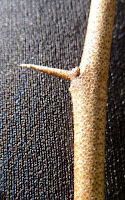 |
| Autumn Olive |
I wasn't aware of the identifying features but once you see them they become obvious. Steve pointed out the silvery green underside of the leaf with its distinctive silver scales. distinctive if you know what to look for. The twigs are light brown with prominent silver and brown scales. The older, thicker branches are armed with sharp thorns.
 |
| Note brown scales, thorns |
 |
| Silver scales- Click to enlarge |
Autumn olive or autumnberry, Elaeagnus umbellata, is part of a long line of "it seemed like a good idea at the time" plantings such as sericea lespideza that were touted as excellent sources of erosion control as well as good for wildlife. It is true that some species of birds eat the berries, but the bad outweighs the good.
"It was studied in the 1940s by the Soil Conservation Service, and the strain 'Cardinal' was released in 1963 for commercial propagation. In the eastern and central United States, autumn olive was planted to provide food and cover for wildlife, as screens, windbreaks and barriers along highways, to stabilize and revegetate road banks, and to reclaim mine spoil. For some years after planting the plant seems contained, but then it suddenly becomes invasive and difficult to control." MDC
These invaders spread rapidly, grow into dense bushes or small trees and shade out native species. By suppressing diversity, they choke out many native species which are also insect host plants. Insects are important links in the food chain. A dense field of autumn olive can reduce the species of butterflies, moths and their caterpillars plus other species that insectivorous birds that depend upon. Its ability to fix nitrogen, somewhat unique among shrubs, is another negative as many native species in prairies, savannas and woodlands don't tolerate large amounts of nitrogen in the soil.
Some sources tout the "autumnberry" as a food source.
We are proponents of eating garlic mustard in salads and sandwiches,
obtained as we pull the invaders out of the ground. My concern with
autumnberry is the fact that harvesting the berries does little to
control the spread. People developing a taste for them may be tempted
to protect their source rather than destroy it, or worse yet, plant it. What ever they taste like, it can't make up for the damage to our Ozark environment.
Treatment of our autumn olive shrub started with my trusty Stihl, followed by Barb's loving application of concentrated Vitamin G glyphosate) on the cut stumps.
This MDC site has comprehensive information about control.

